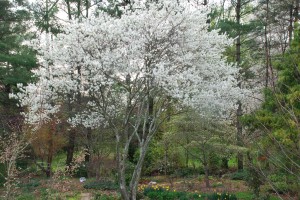On an early late winter’s morn, the frosty appearance from a nearby mountainside may actually be from our native serviceberries (Amelanchier spp.) (USDA hardiness zones 4-9). Serviceberry’s small white blooms frequently signals that winter’s end is near. Flowering may last 7-10 days.
Downy serviceberry (A. arborea) and shrubby Allegheny serviceberry (A. laevis) are commonly planted. Amelanchier is regionally called many names, including shadbush, shadblow, sarvisberry, sarvis tree, and Juneberry. The latter refers to the small greenish-blue, ripening red fruits in late May in the Southern Appalachian region (USDA hardiness zones 6 and 7).
Berry hungry birds don’t wait for fruits to ripen before devouring them. A popular favorite among native tree and bird watchers, the average full service garden center stocks very few during their spring sales rush.
Annual growth rate is rapid, 20 to 30 feet tall and 15-20 feet wide. Serviceberry tolerates many types of soil, preferring a moist, acidic, well-drained soil, and partial to full day sun. The tree often develops multi-trunked. Water and mulch a newly planted tree until it is established. Within two years a tree can handle moderately dry spells. If pruning is needed, do so in the spring after flowering.
In most years, serviceberries suffer from few disease and pest issues. In a rare wet summer, severe leaf spotting may force leaves to rain down in August and dash all hopes of fall color. Both Autumn Brilliance™ and Princess Diana™ are popular cultivars with stunning red fall color in most years.
Serviceberry’s multi-trunked branching fashions a wonderful winter silhouette on a dreary snowy day.


 Posted in
Posted in 
